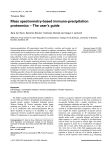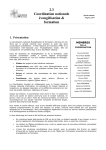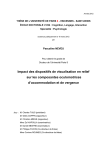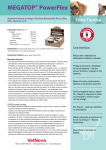Download A user's guide to animal welfare science
Transcript
Opinion TRENDS in Ecology and Evolution Vol.21 No.2 February 2006 A user’s guide to animal welfare science Marian Stamp Dawkins Department of Zoology, South Parks Road, Oxford, OX1 3PS, UK Here, I provide a guide for those new to the burgeoning field of animal welfare science as to what this comprehensive, relatively young discipline is all about. Drawing on all branches of biology, including behavioural ecology and neuroscience, the science of animal welfare asks three big questions: Are animals conscious? How can we assess good and bad welfare in animals? How can we use science to improve animal welfare in practice? I also provide guidelines for an evidencebased approach to welfare issues for policy makers and other users of animal welfare research. Introduction Animal welfare issues increasingly force themselves onto everyone’s agenda: scientists have to provide environmental enrichment for their animals for welfare reasons [1]; zoos are under pressure for confining wild animals in cages [2]; farming practices are criticized and debated [3] and people are urged to buy free-range eggs and meat on the grounds that the welfare of the animals is better. Many welfare issues are so vast that people avoid thinking about them. For example, 2!1010 broiler chickens are killed for meat worldwide each year [4], and uncounted millions of rodents are killed, most commonly with anticoagulant poisons, because they are pests [5]. Here I provide a guide to the burgeoning science of animal welfare, now one of the most comprehensive of all the biological sciences, a discipline that embraces behavioural ecology, evolution, neuroscience, animal behaviour, genetics, cognitive science and even consciousness studies. The guide is intended for ‘users’ of animal welfare science, not so much those already working in the field, but the many other people for whom the results of welfare research increasingly matter, such as philosophers interested in animal emotions, politicians and legislators confronted with public demands for improvements in the treatment of animals and behavioural ecologists interested in the ways animals make decisions and respond to real and perceived threats to their fitness [6]. Indeed, I hope to encourage more readers of TREE to take up some of the challenges raised by studying the welfare of animals (Box 1). The views expressed are my own. Corresponding author: Dawkins, M.S. ([email protected]). Available online 10 November 2005 What is animal welfare science? Animal welfare is no more – and no less – difficult to define than is human welfare [6,7]. When we talk about good welfare for humans, we mean that someone is in good health and that their emotions are generally positive: that they are ‘fit and feeling good’ [8]. Poor human welfare comes not only from ill-health, injury and disease but also from states such as stress, frustration, boredom, loneliness or grief. Many of these mental symptoms also appear as physical symptoms, but not always, so that, for humans, we make a distinction between physical wellbeing and mental well-being. So it is with animals [6–8]. Good animal welfare also starts with physical health, which is why animal welfare sciences has its roots in veterinary medicine, although it does not stop there. Good welfare implies that animals also have positive emotions, such as pleasure and contentment, rather than negative ones, such as fear or frustration, which we humans label ‘suffering’ [7,8]. Animal welfare science has met this challenge by asking three big questions: (i) Are animals conscious? (ii) How can we assess good and bad welfare in animals? (iii) How can science be used to improve animal welfare in practice? Are animals conscious? Although many people believe (without the need for science) that other animals consciously experience pain and suffering in ways that are similar to the ways in which humans do, an exciting development in animal welfare science is that it is now beginning to embrace advances in other disciplines that tackle the issues of consciousness itself [9–11] and so can potentially appeal to those more sceptical people for whom the issue of animal consciousness is not obvious. From a scientific point of view, human consciousness is the hardest problem in biology [12,13]. We have no idea how the populations of nerve cells that comprise our brains give rise to conscious thoughts and emotions or even the most basic feelings of pain and hunger (sentience) in ourselves. This ignorance of how our own consciousness is caused makes it difficult to know what to look for as evidence for it in other species, particularly those, such as birds, whose brains are anatomically different from ours [14]. The situation is further complicated by recent discoveries from psychology that many complex actions in humans (e.g. driving a car or playing a musical instrument) can be carried out quite unconsciously [11,12,15]. www.sciencedirect.com 0169-5347/$ - see front matter Q 2005 Elsevier Ltd. All rights reserved. doi:10.1016/j.tree.2005.10.017 78 Opinion TRENDS in Ecology and Evolution Vol.21 No.2 February 2006 Box 1. The behavioural ecology of animal welfare (a personal view) Adopting an evolutionary approach could help us to understand what might improve animal welfare, for the following reasons: (i) The domesticated and captive species whose welfare concerns so many people carry with them an evolutionary legacy of responses that, in the wild, helped them to survive and reproduce (e.g. fleeing from predators, seeking water or shelter) (Figure I). (ii) These mechanisms are of two types: direct threats to fitness (which can be assessed as reduced health and loss of reproductive success) and anticipated threats to fitness, where the animal behaves ‘as if’ trying to avoid some future danger [6,7]. For example, a perfectly healthy animal with no predator in sight might be highly motivated to seek cover because natural selection has favoured those of its ancestors that had an emotional state of fear in open spaces and immediately sought cover. (iii) Good welfare consists of good physical health (no direct threats to fitness) and the animal having what it wants (no anticipated threats to fitness that are stimulating the animal to escape or seek something it needs). (iv) The ethical issues in animal welfare arise from the fact that the direct and indirect threats to animal fitness are caused by human beings. (v) Paradoxically, it is the evolved mechanisms for coping with anticipated threats to fitness (such as the fear that leads an animal to avoid a dangerous place) that causes more concern about welfare than the direct threats themselves. Humane death, for example, is regarded as less of a welfare problem than causing pain, fear or frustration to a healthy animal. [6]. (vi) Behavioural ecologists have a major role to play in understanding the mechanisms by which different species respond to threats to their fitness and thus in defining what constitutes ‘welfare’ (health and what the animal wants) for different species. Fruitful lines of investigation might be: the ‘honesty’ or otherwise of signals [53], the dynamics of weaning conflicts, the way animals balance antipredator strategies with their other needs and the role of social facilitation decision-making. Just understanding how the time budgets of captive or domestic animals differ from those of their wild or feral counterparts provides a baseline or jumping off point for Figure I. Pig-rearing system inspired by a study of feral pig behaviour [59]. Photograph reproduced with permission from FAI (http://www.faifarms.co.uk). assessing welfare. Some human patients with certain sorts of brain damage can successfully reach out and touch objects in front of them but then say that they are not conscious of seeing them at all [16]. They are thus simultaneously blind (consciously) and sighted (unconsciously guided reaching). For much of what we do, there appear to be multiple routes to the same behaviour, only some of which involve consciousness [15]. But if the same action (e.g. breathing or stretching a limb) can occur in humans through either a conscious or an unconscious pathway, the argument that if the behaviour of another animal is similar to that of a human, that animal too must be conscious [17] is weakened. An animal could be doing the same behaviour but using its evolutionarily older unconscious circuits [18]. Even human emotions can be unconscious [15,19]. For example, people can be subliminally influenced in how they interpret a stimulus by a brief (50 ms) flash of a happy or sad face immediately beforehand, even when they have no conscious awareness of having seen any faces [20]. Greater understanding of the human brain has thus made deciding which non-human animals are conscious more difficult than ever. However, new research findings have opened up some intriguing ways forward. Animal cognition Griffin [21] argued that consciousness in humans evolved to enable adaptively flexible behaviour and that, therefore, the best way to find evidence for consciousness in animals would be to look for adaptively flexible behaviour in other species. The problem, as we have seen, is to make the link www.sciencedirect.com between the complexity of behaviour and conscious experience. For example, chimpanzees can recognize themselves in mirrors in the sense that they use mirrors to respond to, or examine parts of, their bodies that they cannot usually see [22]. Although this might indicate selfawareness and a conscious knowledge of self [23,24], there is no necessary conscious component at all [25]. The complexity of social life has been suggested as the driving force for the evolution of consciousness, on the grounds that deception, cheating and trying to outwit cheaters require a particularly complex type of forward planning and perspective taking [26]. However, apparently complex outcomes can result from simple rule-following [27]. For example, ‘cheats’ do not have to be detected by an elaborate working out of ‘what would I do in his place?’, but lose out to simple strategies such as tit-for-tat and its variants [28] in which animals remember what happened in past encounters and act accordingly. Even simpler ‘win-stay-lost shift’ strategies result in animals moving away from places where social rewards are not forthcoming [29] so that non-cooperators automatically lose out on long-term benefits with no consciousness on either side. Recently, particular attention has been focused on the possibility that animals monitor the state of their own memories. Monkeys perform better on some tasks when allowed to choose for themselves whether to take the test or an easier but less rewarding option than when the experimenter decides for them, suggesting that the monkeys knew how much they knew [30]. Although we should not forget that computers can be programmed to Opinion TRENDS in Ecology and Evolution behave differently depending on how uncertain they are about an outcome, experiments of this sort have opened up new possibilities for asking animals about what they think they know even though we cannot use words to ask them [9,11]. Studies of animal cognition continue to amaze us with what animals can do and deliver a major assault, if not a complete solution, to the problem of animal consciousness. Pleasure and suffering The second category of evidence for animal consciousness centres more explicitly on basic sensations of pain, pleasure and suffering, also called sentience or ‘phenomenal consciousness’ [31]. One approach is to ask humans about their conscious experiences of pain or pleasure and then to use the similarity of behaviour of humans and other animals, such as rats, when both are, say, deprived of water, to infer that the thirsty rat, similar the thirsty human, has the same conscious experience of pleasure in the taste of water [32]. Impressive in this context is the phenomenon of selfmedication (i.e. animals learning to give themselves drugs that are known to give relief from pain or anxiety in humans) [33]. Broiler chickens given the choice between two coloured foods, one of which contained Carprofen, a non-steroidal anti-inflammatory drug that relieves pain in humans, will learn to choose the colour with the analgesic, but only if they themselves are lame and have obvious leg weaknesses. Healthy birds have no such preference [34]. For many people, this is enough to show that birds with bad legs experience pain in the same way that we do, but strictly speaking, a non-conscious explanation is possible. A vehicle could be designed to fill itself with one of several kinds of lubricant, based on which one had, in the past, been shown to result in the lowest fuel consumption. It could be said to find one lubricant more ‘rewarding’ (more likely to be ingested in future). It would not have to be conscious. The gap between doing and feeling is still there, however small it might seem. Anatomy and brain function The most direct way of deciding whether animals are conscious would be to compare their physiological equipment and brain functions with our own [35]. Pain in mammals [36,37] and, to a lesser extent, birds [38] has been well studied and, more recently, the discovery of nocioceptors in fish [39] has led to the view that they also feel pain and can suffer [40,41]. On the basis of physiological and behavioural responsiveness, even invertebrates cannot be dismissed [42]. But definite answers to the questions of whether they consciously experience pain as we do (does their pain hurt?) and suffering (does it matter to them?) remain frustratingly elusive [10,43], particularly as our own pain can be modulated by input from different brain pathways [44]. Far from resolving the question of animal consciousness, comparative brain anatomy has lead McPhail [16] to conclude that only humans are conscious, and Baars [45] to come to the different conclusion that at least all vertebrates are. Even the promise of being able to use non-invasive brain imaging techniques such as PET and fMRI, to www.sciencedirect.com Vol.21 No.2 February 2006 79 compare human and animal brains [23] will be a long time bearing fruit. It has been more difficult than anticipated to find the neural basis of consciousness in humans [12,31] Consciousness, as an evolved feature, is properly part of biology, but, it is difficult to study. How can good and bad welfare be recognized? The second major question that animal welfare science deals with is how to measure and assess animal welfare [7,46]. Poor physical health, caused by disease, injury or deformity, is relatively straightforward to recognize and can often be quantified, for example, by scoring how well an animal is walking or the size of lesions on its body. Other, less obvious measures of decreased health, such as depressed immune function [47], resource-dependent changes in the sex ratio of offspring and reduced food intake [48], have recently been imported from other disciplines. These can often give an indication that all is not well with the animal before clinical symptoms become obvious. To go further and investigate the mental health state of an animal, we can use both physiology and behaviour. The physiological measures of welfare that have been used so far have been autonomic responses, such as increased heart rate and raised levels of hormones such as corticosteroids (‘stress hormones’ [7,49]. Although these are objective measures, they can be difficult to interpret in welfare terms because many of these changes are part of the adaptive way in which the animal responds to its environment, and because apparently pleasurable activities, such as sex and hunting prey, can lead to similar changes to those that are apparently unpleasant, such as escaping a predator [50,51]. Even in humans, it is difficult to judge whether someone is feeling angry, fearful or just plain excited just from knowing what their autonomic responses are [52]. We will never understand the physiology of animal emotions just by looking at autonomic responses. We need to understand what is going on in their brains [23]. Behaviour has the advantage that it can be studied non-invasively and can give a direct insight into the view of the situation from the perspective of the animal. For example, the squeals of piglets give an ‘honest’ indication of how hungry they are [53]. The apparently simple question: ‘Does the animal have what it wants?’ is the key both to whether it is being treated in ways it dislikes (e.g. pain it wants to avoid) and to whether it is deprived (it wants something it does not have) [54]. We now have several different ways of ‘asking’ animals what they want and whether they find the situations they are in pleasurable or distressing.. For example, rats have been shown to press a bar more for the reward of being allowed access to a cage containing other rats than they will for an empty cage, indicating that being with social companions is something they want [55]. Caged mink will push doors to gain access to a water bath and will continue to do so even when the doors are loaded with weights, but they will not make this effort for an empty cage or a cage full of novel objects [56], suggesting that access to water to swim in is something that is important to them. Faced with a diversity of different welfare ‘measures’, some of which seem to contradict each other (animals do 80 Opinion TRENDS in Ecology and Evolution not always choose what is best for their long-term health, for example), animal welfare scientists have taken one of two complementary approaches. One strategy is to take the sum of as many measures as possible (behavioural, health, physiological) and to use a check list of different ones [57], and to ‘triangulate’ on what is good welfare. The other is to focus on just the two questions: ‘are the animals healthy?’ and ‘do they have what they want?’ [54]. For example, the fifth of the ‘Five Freedoms’ that the Farm Animal Welfare Council [58] argued were essential to good welfare is the ‘Freedom to perform most natural patterns of behaviour’. But is natural behaviour essential for welfare? After all, being chased by a predator is natural for most wild animals but it is not obviously good for welfare. By asking whether the health of an animal is improved by being allowed to behave naturally and whether the animal shows evidence of wanting to do the behaviour, we can distinguish between natural behaviour that does improve welfare and that which might not [59]. Similarly, the distinction between stereotypies (repeated fixed behaviours with no apparent function) that might indicate reduced welfare [7] and those that are positively beneficial for the animal [60] can equally be established using the ‘two question’ approach. Some stereotypies actually seem to benefit the health of the animal. Repeated biting of wooden doors or food troughs shown by some stabled horses [61], for example, is associated with reduced gastric ulcers, possibly because the ‘abnormal’ behaviour stimulates the production and swallowing of salive which in turn protects the stomach from excess acid. Others, such as bar-biting in restricted sows, where the animal rubs its mouth until it bleeds, indicate poor welfare on the most basic health grounds [7]. As emphasized earlier, there is no one single measure of welfare. How can science be used to improve animal welfare in practice? Having measured good and bad welfare, it is then necessary to translate what has been found into Box 2. Improving animal welfare in practice Genuine improvements in the welfare of animals are most likely to occur if legislators and other users of animal welfare science follow certain key guidelines: (i) Suggested improvements in animal welfare, such as environmental enrichments, giving animals more space, should be based on answers to two questions: will they genuinely improve animal health? Will it give the animals something they want? (ii) Many different sorts of measurements – health, behaviour and physiology – might have to be made to answer these as there is no single measure of welfare. (iii) Answers should, as far as possible, be derived in situ – in the place where there is concern for animals such as on commercial farms and in zoos, rather than from small scale studies which might not reflect the real world. This means using large scale experiments, an epidemiological approach or systematic meta-analysis of published data. (iv) Giving animals ‘the benefit of the doubt’ and enacting legislation without such evidence might give short-term satisfaction to campaigners but could make genuine improvements more difficult to achieve by distracting resources and attention. (v) Improvements in animal welfare should be studied in the context of human health, food safety and environmental protection. www.sciencedirect.com Vol.21 No.2 February 2006 improvements in the treatment of real animals – those on commercial farms and in zoos, for example. Animal welfare science has already resulted in changes to the laws governing the treatment of animals [62,63] but there remains much research that does not get taken up in practice [64]. Although there are many possible reasons for this, including commercial pressures against change, and a lack of funding to develop a research idea into a practical solution, the way in which research is conceived and conducted might have also been partly responsible. Two recent developments might help to change that (Box 2). First, it is increasingly recognized that carrying out research on commercial farms in cooperation with farmers and other ‘end-users’ will greatly increase the applicability of the results of welfare research compared to relying on smaller scale studies carried out in a laboratory. This involvement can take the form of epidemiological studies of what is currently happening on farms [65] and even participation in farm-level experiments. For example, 11 major broiler chicken producers in the UK and Denmark recently agreed to manipulate the stocking density (‘crowding’, as measured by kg mK2) of whole chicken houses in a coordinated experiment that involved O2.7 million birds [66]. This gave policy makers a better preview of the probable effect of enacting legislation to change stocking density than any small-scale laboratory could have done and indicated that limiting stocking density would have much less effect on chicken welfare than previously supposed. Working directly with farmers has the further advantage that other factors, such as food safety, can be studied simultaneously so that policy decisions can be based not only on what is best for animal welfare, but also in the wider context of human health, effects on the environment and what the public wants to see happening [67]. Second, critically evaluating already published data through the evidence based approach that has revolutionized clinical medicine [68] and is beginning to be used in veterinary medicine [69] and conservation [70,71] greatly increase the value of research findings. Although it might seem obvious to say that animal welfare decisions should be evidence based, this is by no means always the case in practice. For example, a recent European Union report on the welfare of broiler chickens [4] based its conclusions for legislation on O500 publications, but made no attempt to rank the publications on their research quality, magnitude of effect, sample size or whether the studies were conducted on commercial farms or in small groups. By contrast, controversial issues such as whether ‘enrichments’ really improve welfare [2] or what can be done to reduce stereotypies in zoo animals [59,72] are now being tackled more usefully by objective evaluation of large numbers of already published research papers. Conclusions Animal welfare science thinks big. It asks big questions about animal consciousness, animal health and animal emotions and it tackles big issues that affect millions of people and billions of animals. To do so, it draws on a variety of new techniques and approaches so that it is now one of the most comprehensive of all the biological Opinion TRENDS in Ecology and Evolution sciences. Animal consciousness is central to the study of animal welfare but is still, tantalizingly, the ‘hard problem’ and needs to be respected as such. There is no single measure of animal welfare (no convenient equivalent of a litmus test) but focusing on two issues – what improves animal health and what the animals themselves want – will help to bring about genuine improvements to animal welfare in practice and ensure that legislators can make evidence-based decisions. Although the most controversial issues in animal welfare concern the way humans treat captive and domestic animals, the ways those animals respond are rooted in their evolutionary past and in how their wild ancestors responded to threats to their fitness. Behavioural ecologists thus have a major contribution to make to animal welfare science by connecting this evolutionary legacy to what now matters to the animals themselves. Acknowledgements I thank Roland Bonney, Tracey Jones, Ruth Layton and Edmund Rolls for their comments. References 1 Benefiel, A.C. et al. (2005) Mandatory “enriched” housing of laboratory animals: the need for evidence-based evaluation. ILAR J. 46, 95–105 2 Hosey, G.R. (2005) How does the zoo environment affect the behaviour of captive primates? Appl. Anim. Behav. Sci. 90, 107–129 3 Weaver, S.A. and Morris, M.C. (2004) Science, pigs and politics: a New Zealand perspective on the phase-out of sow stalls. J. Agric. Environ. Ethics 17, 51–66 4 Scientific Committee on Animal Health and Animal Welfare (2000) The Welfare of Chickens Kept for Meat Production (Broilers). European Commission (http://europa.eu.int/comm/food/fs/sc/scah/out39_eupdf) 5 Mason, G.J. and Littin, K.E. (2003) The humaneness of rodent pest control. Anim. Welf. 12, 1–37 6 Dawkins, M.S. (1998) Evolution and animal welfare. Q. Rev. Biol. 73, 305–328 7 Broom, D.M. ed. (2001) Coping with Challenge. Welfare in Animals including Humans, Dahlem University Press 8 Webster, A.J.F. et al. (2004) Welfare assessment: indices from clinical observation. Anim. Welf. 13, S93–S98 9 Mendl, M. and Paul, E.S. (2004) Consciousness, emotion and animal welfare: insights from cognitive science. Anim. Welf. 13(Suppl.), S17–S25 10 Bateson, P. (2004) Do animals suffer like us? Vet. J. 168, 110–111 11 Paul, E.S. et al. (2005) Measuring emotional responses in animals: the utility of a cognitive approach. Neuro. Biobehav. Rev. 29, 469–491 12 Blackmore, S. (2003) Consciousness: An Introduction, Hodder & Stoughton 13 Koch, C. (2004) The Quest for Consciousness: A Neuroscientific Approach, Roberts & Co 14 Burish, M.J. et al. (2004) Brain architecture and social complexity in modern and ancient birds. Brain Behav. Evol. 63, 107–124 15 Rolls, E.T. (2005) Emotion Explained, Oxford University Press 16 Weiskrantz, L. (2003) Roots of visual awareness. Prog. Brain Res. 144, 229–241 17 de Waal, F. (2005) Animals and us: suspicious minds. New Scientist 2502, 48 18 McPhail, E.M. (1998) The Evolution of Consciousness, Oxford University Press 19 Berridge, K.C. and Winkielman, P. (2003) What is an unconscious emotion? (The case for unconscious “liking”). Cogn. Emotion 17, 181–211 20 Murphy, S. and Zajonc, R. (1993) Affect, cognition and awareness – affective priming with optimal and suboptimal stimulus exposures. J. Pers. Soc. Psychol. 64, 723–739 21 Griffin, D.R. and Speck, G.B. (2004) New evidence for animal consciousness. Anim. Cogn. 7, 5–18 www.sciencedirect.com Vol.21 No.2 February 2006 81 22 Gallup, G.G., Jr. (1970) Chimpanzees: self recognition. Science 167, 86–87 23 Platek, S.M. et al. (2004) Where am I? The neurobiological correlates of self and other. Cogn. Brain Res 19, 114–122 24 Bekoff, M. and Sherman, P.W. (2003) Reflections on animal selves. Trends Ecol. Evol. 19, 176–180 25 Heyes, C.M. (1998) Theory of Mind in non-human primates. Behav. Brain Sci. 21, 101–114 26 Byrne, R.W. and Corp, N. (2004) Neocortex size predicts deception rate in primates. Proc. R. Soc. Lond. B Biol. Sci. 271, 1693–1699 27 Sachs, J.L. (2004) The evolution of cooperation. Q. Rev. Biol. 79, 135–160 28 Chen, M.K. and Hauser, M. (2005) Modelling reciprocation and cooperation in primates: evidence for a punishing strategy. J. Theor. Biol. 235, 5–12 29 Bshary, R. and Schaffer, D. (2002) Choosy reef fish select cleaner fish that provide high quality service. Anim. Behav. 63, 557–564 30 Hampton, R.R. (2001) Rhesus monkeys know when they remember. Proc. Natl. Acad. Sci. U. S. A. 98, 5359–5362 31 Block, N. (2005) Two neural correlates of consciousness. Trends Cogn. Sci. 9, 46–52 32 Ramirez, J.M. and Cabanac, M. (2003) Pleasure, the common currency of emotions. Ann. N. Y. Acad. Sci. 1000, 293–295 33 Sherwin, C.M. and Olsson, A.S. (2004) Housing conditions affect selfadministration of anxiolytic by laboratory mice. Anim. Welf. 13, 33–38 34 Danbury, T.C. et al. (2000) Self-selection of the analgesic drug carprofen by lame broiler chickens. Vet. Rec. 146, 307–311 35 Bermond, B. (2001) A neuropsychological and evolutionary approach to animal consciousness and animal suffering. Anim. Welf. 10, S47–S62 36 Rutherford, K.M.D. (2002) Assessing pain in animals. Anim. Welf. 11, 31–54 37 Moloney, V. et al. (2002) Validation of a method for assessment of acute pain in lambs. Appl. Anim. Behav. Sci. 76, 215–238 38 Gentle, M.J. (1992) Pain in birds. Anim. Welf. 1, 235–247 39 Sneddon, L.U. et al. (2003) Do fish have nocioceptors? Evidence for the evolution of a vertebrate sensory system. Proc. R. Soc. Lond. B Biol. Sci. 270, 1115–1121 40 Rose, J.D. (2002) The neurobehavioral nature of fishes and the question of awareness and pain. Rev. Fish. Sci. 10, 1–38 41 Chandroo, K.P. et al. (2004) Can fish suffer? Perspectives on sentience, pain, fear and stress. Appl. Anim. Behav. Sci. 86, 225–250 42 Sherwin, C.M. (2001) Can invertebrates suffer? Or how robust is the argument from analogy? Anim. Welf. 10, S103–S118 43 Chapman, C.R. and Nakamura, Y. (1999) A passion for the soul: an introduction to pain for consciousness researchers. Conscious. Cogn. 8, 391–422 44 Rainville, P. (2002) Brain mechanisms of pain affect and pain modulation. Curr. Opin. Neurobiol. 12, 195–200 45 Baars, B.J. (2001) There are no known differences in brain mechanisms of consciousness between humans and other mammals. Anim. Welf. 10, S31–S40 46 Appleby, M.C. and Hughes, B.O. eds. (1997) Animal Welfare, CAB International 47 Irwin, M. (1999) The immune correlates of depression. Adv. Exp. Med. Biol. 461, 1–24 48 Dallman, M.F. (2001) Stress and sickness decrease food intake and body weight: How does this happen? When does this adaptive response progress to pain and suffering?. In Coping with Challenge. Welfare in Animals including Humans (Broom, D.M., ed.), pp. 301–316, Dahlem University Press 49 Korte, S.M. (2001) Corticosteroids in relation to fear, anxiety and psychopathology. Neurosci. Biobehav. Rev. 25, 117–142 50 Rushen, J. (1991) Problems associated with the interpretation of physiological data in the assessment of animal welfare. Appl. Anim. Behav. Sci. 28, 381–386 51 Toates, F. (1995) Stress: Conceptual and Biological Aspects, John Wiley & Sons 52 Oatley, K. and Jenkins, J.M. (1996) Understanding Emotions, Blackwells 53 Weary, D.M. and Fraser, D. (1995) Calling by domestic piglets: reliable signals of need? Anim. Behav. 50, 1047–1055 Opinion 82 TRENDS in Ecology and Evolution 54 Dawkins, M.S. (2004) Using behaviour to assess welfare. Anim. Welf. 13, S3–S7 55 Patterson-Kane, E.H. et al. (2002) Rats demand social contact. Anim. Welf. 11, 327–332 56 Mason, G.J. et al. (2001) Frustrations of fur-farmed mink. Nature 410, 35–36 57 Whay, H.R. et al. (2003) Animal-based measures for the assessment of welfare state of dairy cattle, pigs and laying hens: consensus of expert opinion. Anim. Welf. 12, 205–217 58 Farm Animal Welfare Council (1993) Second Report on Priorities for Research and Development in Farm Animal Welfare, Ministry of Agriculture Fisheries and Food 59 Stolba, A. and Wood-Gush, D.G.M. (1989) The behaviour of pigs in a semi-natural environment. Anim. Prod. 48, 287–298 60 Mason, G.J. and Latham, N.R. (2004) Can’t stop, won’t stop: is stereotypy a reliable animal welfare indicator? Anim. Welf. 13, S57–S69 61 Nicol, C.J. et al. (2002) Study of crib-biting and gastric inflammation and ulceration in young horses. Vet. Rec. 151, 658–660 62 Millman, S.T. et al. (2004) The impact of applied ethologists and the International Society of Applied Ethologists in improving animal welfare. Appl. Anim. Behav. Sci. 86, 299–311 63 Mellor, D.J. (2003) Guidelines for the humane slaughter of the fetuses of pregnant ruminants. Surveillance 30, 26–28 Vol.21 No.2 February 2006 64 Grandin, T. (2003) Transferring results of behavioural research to industry to improve animal welfare on the farm, ranch and the slaughter plant. Appl. Anim. Behav. Sci. 81, 215–228 65 Nicol, C.J. et al. (2003) Matched concurrent case-control study of risk factors for feather pecking in hens on free-range commercial farms in the UK. Br. Poult. Sci. 44, 515–523 66 Dawkins, M.S. et al. (2004) Chicken welfare is influenced more by housing conditions than by stocking density. Nature 427, 342–344 67 Glass, C.A. et al. (2005) Measuring the value to the public of pig welfare imporovements: a contingent valuation approach. Anim. Welf. 14, 61–69 68 Abalos, E. (2005) The tools and techniques of evidence-based medicine. Best Pract. Res. Clin. Obstet. Gynaecol. 19, 15–26 69 Aragon, C.L. and Budsberg, S.C. (2005) Applications of evidencebased medicine: Cranial cruciate ligament injury repair in the dog. Vet. Surg. 34, 93–98 70 Sutherland, W.J. et al. (2004) The need for evidence-based conservation. Trends Ecol. Evol. 19, 305–308 71 Coˆte´, I.M. et al. (2005) Measuring coral reef decline through metaanalysis. Philos. Trans. R. Soc. Lond. B Biol. Sci. 360, 385–395 72 Bashaw, M.J. et al. (2001) A survey assessment of variables relating to stereotypy in captive giraffe and okapi. Appl. Anim. Behav. Sci. 73, 235–247 Forthcoming Conferences Are you organizing a conference, workshop or meeting that would be of interest to TREE readers? If so, please e-mail the details to us at [email protected] and we will feature it in our Forthcoming Conference filler. 23–24 March 2006 Trade-offs in conservation: deciding what to save, Zoological Society of London, UK http://www.zoo.cam.ac.uk/ioz/meetings.htm 6–11 August 2006 91st ESA Annual Meeting, Memphis, USA http://www.esa.org/memphis/ 4–9 June 2006 ASLO Summer meeting, Victoria, Canada http://aslo.org/meetings/victoria2006/ 13–19 August 2006 24th International Ornithological Congress, Hamburg, Germany http://www.i-o-c.org 23–27June 2006 Annual meeting of the Society for the Study of Evolution, State University of New York at Stony Brook, USA http://lsvl.la.asu.edu/evolution/symp06.html 22–26 August 2006 1st European Congress of Conservation Biology, Eger, Hungary http://www.eccb2006.org/ 24–29 June 2006 Society for Conservation Biology, San Jose, USA http://conbio.org/2006/ 4–6 September 2006 ECBB: 3rd Joint European Conference on Behavioural Biology, Belfast, Northern Ireland http://asab.nottingham.ac.uk/meetings/asab.php 11–12 July 2006 BES/IEEM Ecological Impact Assessments: Science and Best Practice, Bath Spa University College, Bath, UK http://www.britishecologicalsociety.org/articles/groups/ conservation/bes_ieem_conf/ 18–22 July 2006 International Fish Biology, St Johns, Canada http://www-heb.pac.dfo-mpo.gc.ca/congress/ 5–7 September 2006 British Ecological Society Annual Meeting, University of Oxford, UK http://www.britishecologicalsociety.org/ 10–14 September 2006 American Society for Fish Biology, Lake Placid, USA http://www.fisheries.org/html/index.shtml 23–29 July 2006 11th International Behavioral Ecology Congress, Tours, France http://www.isbe2006.com/ 3–7 October 2006 American Ornithologist Union, Veracruz, Mexico http://www.naoc2006.org/ 6–10 August 2006 Animal Behaviour Society, Salt Lake City, USA http://www.animalbehavior.org/ABS/Program/Snowbird05/ 18–21 October 2006 Society of Vertebrate Palaeontology http://www.vertpaleo.org www.sciencedirect.com
















